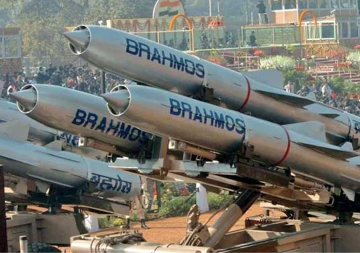After a hiatus of nearly six years, India and Pakistan discussed the Sir Creek border dispute. The Surveyor General of India, assisted by the Chief Hydographer of the Indian Navy led the Indian delegation while the Pakistan side was represented by Ahsan ul Haq Chaudhry, Additional Secretary in the Pakistan Ministry of Defence. After the talks, the two sides issued a joint statement that reiterated the necessity for an early resolution of the issue and also agreed to continue the dialogue and take the discussions forward for an early demarcation of the boundary and settlement of the dispute. Earlier the two sides had issued a joint statement on Siachen Glacier demilitarisation. The discussions on the Sir Creek boundary dispute and demilitarisation of the Glacier are a part of the series of discussions on eight subjects of the composite dialogue process including issues related to combating terrorism and suppressing trade in narcotics. <br /> <br /> Sir Creek is part of the Rann of Kutch, a marshy area that straddles the border between the state of Gujarat in India and Sind province in Pakistan. Sir Creek dispute is as old as 1875 and has its genesis in the boundary dispute between the two princely states of Sind and Kutch. In 1907-08, the British brokered an agreement between the two sides and promulgated the outcome in the form of Map No B-44 that was later published in 1914. This map was subsequently implemented in 1924 in the form of Map No B-74 and both these maps are referred to as the '1914 Resolution Maps'. The Sir Creek dispute resurfaced in 1948 after Pakistan called for delimitation of the Sind/Kutch border. After that, the dispute has remained a low-key issue between the two sides. <br /> <br /> In 1965, the area was witness to bloody clashes and the subsequent events that led to the war. Post war, the two sides referred the dispute to an Arbitration panel that redefined a new boundary between Kutch and Sind. As part of the arbitration, the two sides were to erect pillars but the task was not taken up seriously and thus the demarcation remains incomplete. Between 1989 and 1998, Pakistan and India had at least six bilateral discussions but have failed to arrive at an agreement. <br /> <br /> The Rann of Kutch has been an important battlefield in previous Indo-Pakistani wars. It is marshy, poorly habitable and requires a different type of training and equipment. The Kutch border is manned by the Indian Border Security Force and Pakistani Rangerswho have at their disposal shallow draught/ flat bottom boats to assist in patrolling the Creek area. During the monsoon the area is flooded and makes patrolling difficult. <br /> <br /> In recent times, the area has witnessed at least two military related incidents and has thus gained military significance. First is the Pakistan Navy Atlantique incident. In August 1999, the Indian Air Force shot down a Pakistani naval reconnaissance and surveillance aircraft that intruded well into Indian air space in the Rann of Kutch sector. Apparently, the intrusion was aimed at probing the air defences, identifying gaps and weaknesses, updating intelligence on Indian Army and Air Force radar and communications networks and even more importantly assessing readiness status. The entire crew of 16 (6 officers and 10 sailors) was killed in the incident and the debris of the aircraft fell on either side of the Indo-Pakistan border. Pakistan Army retaliated the next day and opened fire with ground-to-air missiles targeted against Indian helicopters that were carrying journalists to look at debris of the downed Pakistani aircraft. Interestingly, there had been a number of such intrusions in the past and had not invited such a reaction form the Indian Air Force. Pakistani Navy Atlantique aircraft have been, on regular basis, crossing in and out of Indian Air Defence Identification Zones, violating aircraft carrier flying space and flying over the Bombay High. The aircraft is fitted with air-to-surface missiles (such as the anti-ship Exocet) and anti-submarine torpedoes and can be categorized as an armed combat aircraft. <br /> <br /> Pakistani submarines and chariots (mini submarines) have been operating along the Gujarat coast. In December 2003, in a written reply in the Lok Sabha, George Fernandes, the Indian Defence Minister told the Parliament that Pakistan navy submarine operations had been noticed close to the western Gujarat coast for about two months. Besides, the Pakistan army had strengthened its deployment of troops opposite Rann of Kutch and Sir Creek in Gujarat and the Indian armed forces were monitoring the sea and the land deployment and movements of Pakistani troops. Although Pakistan denied Fernandes' statement, Major General Shaukat Sultan said the Pakistani navy was only engaged in peacetime activities and urged Indian authorities to abstain from "baseless" accusations. <br /> <br /> Keeping in mind the military significance of the area and past incidents involving the downing of the Pakistan navy Atlantique aircraft, Pakistan has installed shore based missiles, special forces troops detachments, marine commandoes and deployed at least one battalion of its army. There are also Pakistan Ranger companies and border listening detachments monitoring Indian Air Force air activity and Indian army exercises. Besides, the Pakistan navy has been active in the area. Pakistan does not possess any worthwhile amphibious capability and thus has to rely on its submarines, midgets and chariots for inducting marine commandoes and Special Forces. Given that the terrain is marshy, difficult and patrolled occasionally by the Border Security Force, the situation is ripe for intrusions by terrorist and ISI agents. It is in India's interest to resolve the Sir Creek dispute in an early time frame. During the period of negotiations, India must keep its surveillance facilities in a high state of alert. <br /> <br /> Dr Vijay Sakhuja is Research Fellow at ORF Institute of Security Studies. <br /> (Courtesy: Sahara Time August 28 , 2004) <br /> <br /> <em>* Views expressed in this article are those of the author and do not necessarily reflect those of Observer Research Foundation.</em>
The views expressed above belong to the author(s). ORF research and analyses now available on Telegram! Click here to access our curated content — blogs, longforms and interviews.




 PREV
PREV

